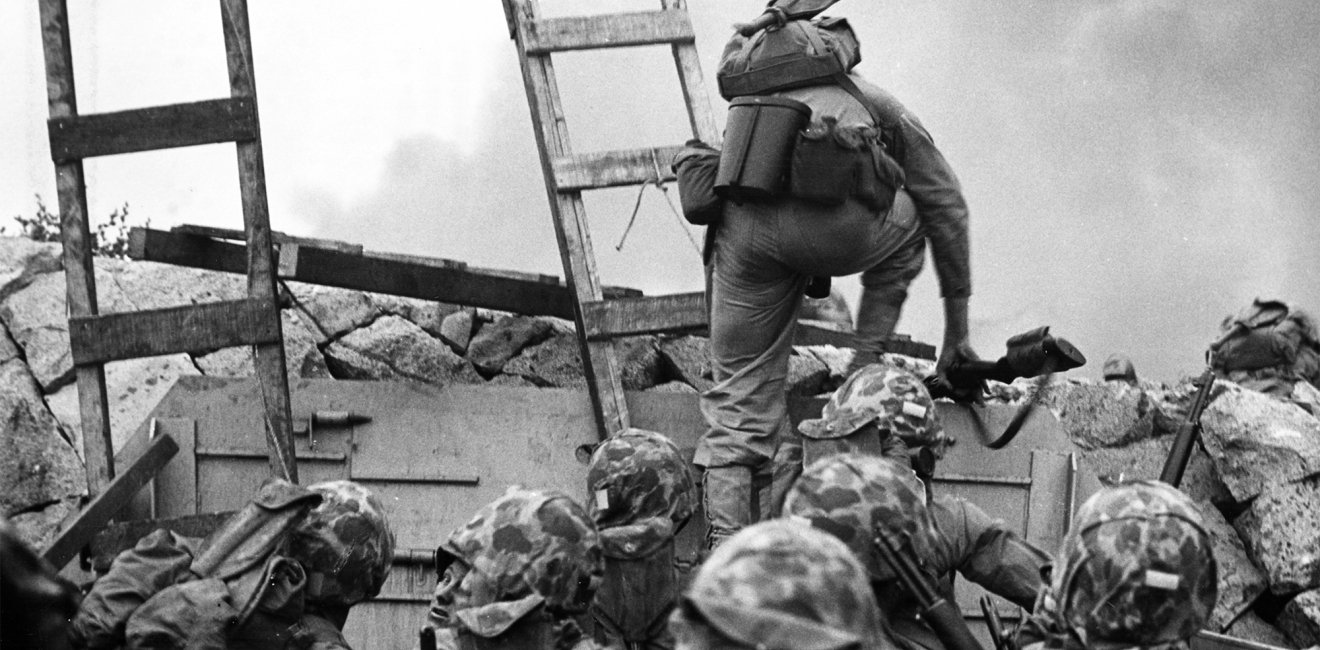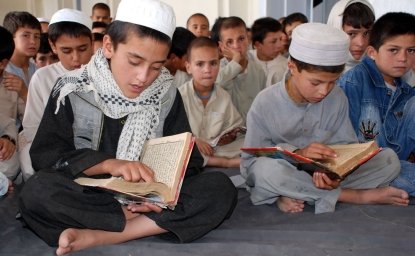
A blog of the Indo-Pacific Program
The Korean War, which broke out 70 years ago in June, is the focus of the summer 2020 issue of the Wilson Quarterly. This week, we also wanted to remember the Inchon Landing, which came at a critical time in the Korean War.
Following North Korea’s capture of Seoul in June 1950 and the Korean People’s Army advance southward, U.S.-led UN coalition forces and South Korean troops struggled to prevent the North Koreans from overtaking the entire peninsula.
Gen. Douglas MacArthur, commander of the UN forces, knew their defense of the Pusan Perimeter was not a viable long-term strategy.
On September 15, when the tide was exactly at 23 feet — allowing naval ships to clear the mudflats — more than 200 U.S.-led United Nations ships and 70,000 military personnel landed on target beaches at the Incheon harbor and began to scale the heavily fortified seawalls, according to U.S. military historians.
The daring amphibious landing led by MacArthur was risky but successful: it singlehandedly changed the tide of the Korean War for South Korea and the UN coalition forces by paving the way for the U.S.-led troops to push north of the 38th Parallel.
Soviet Marshal Matvei Zakharov sent this assessment to Soviet leader Joseph Stalin in late September:
The situation of the People's Army troops on the Western (Seoul) and Southeastern (Busan) fronts is severe.
Seeking to encircle and destroy the main forces of the People's Army, it is in the general direction of Cheongju that the U.S. troops have concentrated the major efforts of the assault group which had landed in the area of Jemulpo (Incheon), as well as of the troops that had launched an offensive from the area to the North and Northwest of Daegu.
He reported that the North Koreans had “lost almost all their tanks and much artillery,” and, most importantly, their stronghold on Seoul.

This pivotal moment in the Korean War has been the focus of several feature films over the decades, in South Korea, the United States — and North Korea.
They range from the sweeping Hollywood film Inchon, released in 1981 and starring Laurence Olivier as MacArthur, to the South Korean production Battle of Jangsari, which premiered in 2019. One, Wolmi Island, recreates the North Koreans’ struggle to hold onto their position just before MacArthur’s assault; a joint South Korean-U.S. production, Operation Chromite, refers to the American codename for the maneuver.
Here is a look at four films about the Inchon Landing. Spoiler alert: various plot points of these films are discussed below.
Inchon

The 1981 film Inchon, directed by Terence Young, is a war epic centering around the larger-than-life MacArthur.
Inchon was a box office flop — the worst of 1982 — and was lambasted by the New York Times for its lack of “dramatic effect” and poorly executed explosions, including bodies that would “fly magically into the air before the shell burst.”
The film cost over $40 million and was entirely funded by the Unification Church and its founder, Rev. Sun Myung Moon. According to Guts and Glory: The Making of the American Military Image in Film author Lawrence H. Suid, the Pentagon was involved in early film decisions and U.S. Marines served as extras. The mix of military and religious input resulted in fascinating yet bizarre scenes such as MacArthur reciting the Lord’s Prayer at a press briefing.
Inchon also leans heavily into a narrative of heroic U.S. Marines freeing helpless South Koreans.
The opening sequence depicts North Koreans haphazardly driving tanks through a rural village, indiscriminately shooting at civilians, and ends with UN coalition tanks parading ceremoniously through a freed Seoul. Grateful South Koreans shout joyfully at the sight while waving South Korea’s taegeukgi flag.
Citing the “many shots of sweet-faced Korean orphans looking fondly at their American benefactors,” the Times described the film as containing a “fawning attitude” over the U.S. involvement.
Even so, the film remains worth mentioning for its periodic surfacing in pop culture.
Wolmi Island

Released in 1982, the North Korean feature film Wolmi Island (월미도) seeks to recreate the dramatic three days before the Inchon Landing.
The tiny island of Wolmi, or Wolmi-do, sits on the doorstep of the modern-day South Korean port city of Incheon, some 100 miles from the 38th Parallel that divides the Korean Peninsula.
Note: Though the 1950 amphibious assault is widely known as the “Inchon Landing,” the port city is known today as Incheon, the transliteration favored by the South Korean government.
In September 1950, North Korean troops had seized the island. Pre-invasion intelligence indicated that about 400 North Korean soldiers had occupied Wolmi-do.
However, the Incheon port was accessible only through a treacherous channel that was obscured by the island, making the neutralization of Wolmi-do essential to the success of the Inchon Landing.
Navy destroyers bombarded the island for more than an hour, shooting more than 1,700 shells, until enemy fire ceased. On the North Korean side, 108 soldiers were killed and 136 captured. The remaining 100-some North Korean soldiers who refused to surrender were sealed into caves by U.S. tank dozers and left to perish, according to U.S. military historians.

Within hours, and with light U.S. Marine casualties, Wolmi-do was neutralized.
The film Wolmi Island depicts this assault from the North Korean perspective.
The plot is described in Korean Film Art, a book written by the Korea Film Export & Import Corporation and published by the Foreign Language Publishing House in Pyongyang in 2016:
“When the fatherland is faced with a grim trial, Company Commander Ri Thae Hun and his coast artillerymen go into battle with a heroic resolve.
On the first day of the battle, they frustrate the enemies’ attempt to land, but with heavy casualties. With death-defying determination not to waste the blood of the fallen comrades they deal an annihilating blow to the enemy once more on the second day. What left are a few gunmen, one gun, and half a dozen rounds of shells. They become human shells and fight like phoenix to defend Wolmi Island and delay the enemy’s landing for three days.”
The plot contradicts U.S. military records, which describe the seizure of Wolmi-do as a 90-minute operation, not a three-day bloodbath as depicted in Wolmi Island.
Today, Wolmi-do is firmly on the South Korean side of the Demilitarized Zone and is home to an amusement park and seafood restaurants.
Operation Chromite

The 2016 film Operation Chromite, directed by John H. Lee, is one of the most recent cinematic depictions of the Inchon Landing. It boasted a hefty budget and starred Liam Neeson playing the role of MacArthur.
Unlike Inchon, Operation Chromite focuses on a clandestine military operation coordinated between MacArthur and U.S. intelligence.
Dubbed “X-Ray” in the film, the intel operation involves a Soviet-trained captain leading operatives who impersonate North Korean officers on a mission to gather military intelligence. Through this mission, MacArthur hopes to gain necessary information on the natural landscape of Incheon as well as the state of North Korean defenses.
Described in one review as a “taut Korean War drama,” Operation Chromite is a highly fictionalized version of the events leading up to the Inchon Landing with tactics “so ridiculously risky that any actual mission pursuing them would probably have been quickly neutralized,” the Hollywood Reporter noted.
Actually, Operation Chromite is loosely based on a real-life mission called Operation Trudy Jackson, which involved a mixed U.S.-South Korean cohort led by U.S. Navy Lt. Eugene Franklin Clark and Lt. Youn Joung of South Korea.
An excerpt from Combat Operations of the Korean War: Ground, Air, Sea, Special and Covert by Paul M. Edwards reads:
“Once ashore, Clark and his band were able to collect information and relay it back to the forces preparing for the invasion. Using locals, he provided information about tides, mudflats, seawalls, and details on what enemy fortifications had been established.”
In both Operation Trudy Jackson and Operation Chromite’s fictional Operation X-Ray, these operatives also crucially secured control of a lighthouse on Palmi-do, which overlooked the Incheon harbor. Through this, they were able to create a beacon for McArthur’s fleet to navigate by the night before the landing.
Battle of Jangsari

Battle of Jangsari: Forgotten Heroes, the second installment in the Operation Chromite trilogy, parallels its predecessor by focusing on a military operation executed in preparation for the Inchon Landing.
Co-directed by South Koreans Kwak Kyung-taek and Kim Tae-hoon, the 2019 film focuses on the involvement of student-soldiers in the Korean War.
On September 14, the day before the Inchon Landing, 772 South Korean soldiers were sent to Jangsari Beach in the small fishing village of Yeongdeok, southeast of Seoul. Their mission: to cut off supplies for the Korean People’s Army.
The film focuses on the crucial but hopeless battle fought by the student-soldiers. As noted by Yonhap News, “As time goes by, the student-soldier unit is cornered and isolated as they lose radio communications and run low on food and ammunition.”
The film also features actress Megan Fox, who portrays a fictional amalgam of real-life Korean War correspondents Marguerite Higgins and Margaret Bourke-White.
Battle of Jangsari is based on a real mission which was kept secret for decades and it mostly draws attention to the plight of student-soldiers who were thrown into battles with little to no combat training and equipment.
If the Inchon Landing was considered high-risk, then both the fictionalized and real-life Battle of Jangsari were suicide missions. Although the film was criticized as “formulaic to a fault,” its depiction of the little-known operation is noteworthy.
Olivia Grotenhuis is a staff intern at the Hyundai Motor-Korea Foundation Center for Korean History and Public Policy. She is a recent graduate of the University of Virginia with her B.A. in foreign affairs and East Asian studies. Sharon Lee is a staff intern at the Hyundai Motor-Korea Foundation Center for Korean History and Public Policy and an undergraduate at the University of Pennsylvania.
Follow the Korea Center on Twitter @Korea_Center or on Instagram at @wilsoncenterkorea.
The views expressed are the author's alone, and do not represent the views of the U.S. Government or the Wilson Center. Copyright 2020, Asia Program. All rights reserved.
Additional Resources
For a look at documentary footage taken by U.S. military personnel, take a look at the Wilson Quarterly timeline of the Korean War, which features video taken during the Inchon Landing.
More declassified wartime cables are available in the Wilson Center’s Digital Archive.
For North Korea’s take on the Korean War, read excerpts from Outstanding Leadership and Brilliant Victory, published in Pyongyang in 1993.
Authors


Indo-Pacific Program
The Indo-Pacific Program promotes policy debate and intellectual discussions on US interests in the Asia-Pacific as well as political, economic, security, and social issues relating to the world’s most populous and economically dynamic region. Read more


Hyundai Motor-Korea Foundation Center for Korean History and Public Policy
The Center for Korean History and Public Policy was established in 2015 with the generous support of the Hyundai Motor Company and the Korea Foundation to provide a coherent, long-term platform for improving historical understanding of Korea and informing the public policy debate on the Korean peninsula in the United States and beyond. Read more





